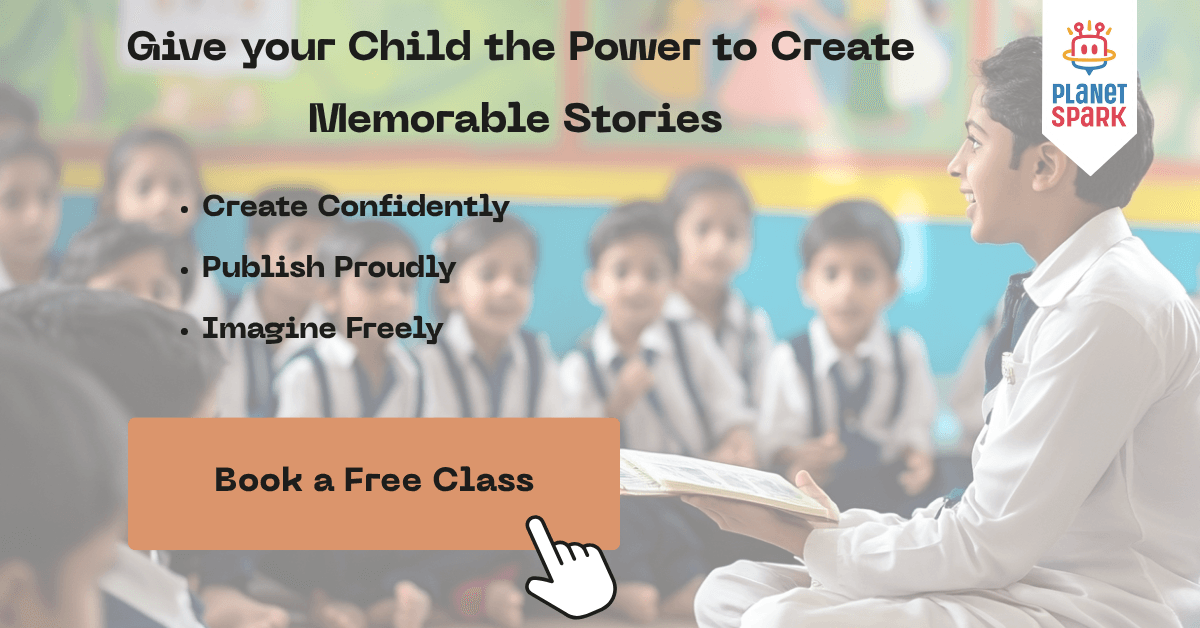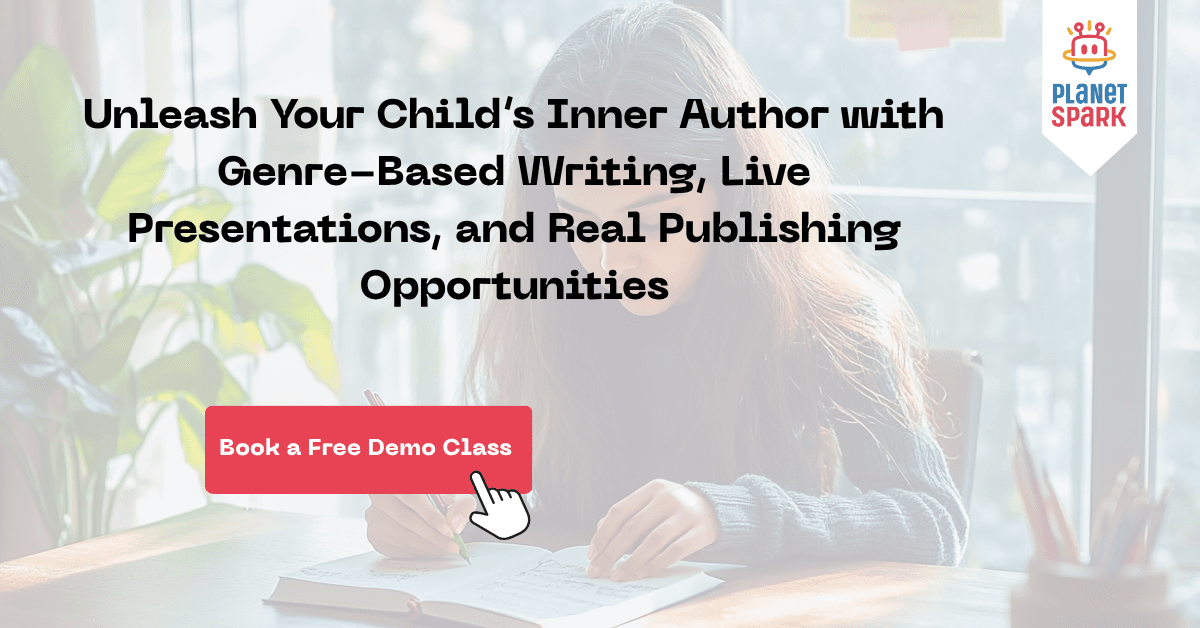Mastering Story Elements: A Complete Guide for Kids

Storytelling is a powerful educational tool, offering children a structured way to understand their world while nurturing creativity and communication. From fables and myths to personal narratives and fantasy tales, stories serve as both mirrors and windows, reflecting children’s experiences and introducing them to new perspectives. When kids grasp the structure of a story, they’re better equipped to analyze, understand, and ultimately create narratives of their own.
At PlanetSpark, storytelling isn’t just a creative outlet; it’s a foundational skill that supports academic success, language development, and confidence-building. Our Story Writing Course for Kids is designed to transition children from passive readers to confident creators. In this blog, we explore the essential elements of storytelling, why they matter, how to teach them, and how PlanetSpark's personalized approach amplifies learning.
Basic Elements of a Story
A well-crafted story comprises a range of specific elements that work together to bring structure, meaning, coherence, and emotional depth to the narrative. These foundational components—setting, characters, plot, conflict, and theme—are essential not only for understanding and enjoying stories but also for creating powerful narratives. Teaching children to identify and use these concepts builds their reading comprehension, critical thinking, and expressive writing abilities.
Benefits of Learning Story Elements
- Encourages imagination and creativity in children
- Develops empathy through character and conflict analysis
- Helps children better understand books, movies, and real-life situations
- Improves writing organization and coherence
- Provides a solid foundation for public speaking and debate

Tips for Parents and Educators
- Incorporate story elements into daily reading time
- Ask your child questions like “Who is the main character?” or “What was the problem in the story?”
- Use art projects to represent elements like setting or mood
- Create a story box filled with objects to inspire storytelling and identify components
Looking to strengthen your child's foundation in storytelling? Consider helping them explore the core elements of plot, setting, and character to build a strong narrative base. Try a free trial class of PlanetSpark’s Story Writing Course today.
Story Resolution
- A story's resolution is where the conflict finds closure, and the journey of the characters reaches a turning point or end
- Whether it's a twist ending, a happily-ever-after, or a reflective pause, the resolution brings emotional satisfaction and rounds off the plot structure
- Teaching children to identify resolutions helps them understand pacing, narrative arcs, and the power of emotional payoff
Conflict Engagement
- Conflict is not just about battles—it’s about obstacles, choices, and growth
- Children should explore different kinds of conflict, such as character vs self, character vs society, and character vs nature
- Ask guiding questions: What is your character fighting for? What stands in their way?
- Identifying internal and external conflicts helps students write with more depth and emotional nuance
Techniques to Teach Advanced Story Elements
Once students understand what the advanced elements are, it’s equally important to teach them how to use those elements effectively. Here are some strategies that parents and educators can use:
Story Rewrites
- Ask children to rewrite a familiar story from a different point of view, such as turning a third-person story into a first-person narrative
- This encourages them to think about how the narrator’s perspective changes tone and access to information
Mood Boards
- Help children create visual collages or digital mood boards that represent the mood of their story
- They can include colors, images, and phrases that capture the emotions they want to evoke
Tone Exploration Activities
- Provide students with the same passage written in different tones (e.g., humorous vs. serious) to discuss how tone affects the reader’s experience
- Encourage students to try rewriting their scenes with alternative tones

Style Discovery Journals
- Ask students to read short stories by different authors and note differences in style
- Students can then experiment with mimicking those styles in their writing
Mood Walks
- Invite students to walk through a neighborhood or park while imagining it as the setting for different genres—mystery, fantasy, or drama
- This helps them connect sensory details to mood and tone
Reflection Questions
After writing a draft, children can reflect on questions like:
- What mood does my story create?
- Does my tone match the plot and characters?
- Am I consistent in my narrative voice?
Ready to help your child dig deeper into storytelling and develop a unique voice? Enroll in a free PlanetSpark trial session and discover how our personalized coaching helps young writers master advanced storytelling techniques.
Explore PlanetSpark's Comprehensive Support for Storytelling Mastery
1:1 Personal Trainers for Every Child
- Each child is paired with a certified communication expert
- Trainers tailor sessions to individual learning styles, pace, and personality
- Real-time feedback fosters rapid growth in storytelling, fluency, grammar, and creativity
Personalised Curriculum and Learning Roadmap
- Begins with skill assessment to design a tailored roadmap
- Identifies gaps in vocabulary, grammar, structure, and confidence
- Updated regularly based on progress and feedback
SparkX – AI-Enabled Video Analysis Tool
- Children upload videos of stories or speeches
- AI evaluates fluency, grammar, body language, confidence, and structure
- Parents receive actionable feedback and performance reports
AI-Led Practice Sessions
- Practice outside class hours with a virtual AI coach
- Activities include story narration and prompt responses
- Real-time feedback on tone, fluency, grammar, and delivery
Spark Diary – Nurturing Daily Writing Habits
- A digital journaling tool for stories, poems, and reflections
- Builds consistent writing practice and creativity
- Promotes clarity, structure, and emotional expression
Gamified Learning for Engagement
- Games like Antonyms Quiz, Word Wisdom, and Grammar Guru Challenge
- Helps reinforce spelling, listening, grammar, and vocabulary
- Daily fun activities encourage participation and retention
Structured PTMs (Parent-Teacher Meetings)
- Share the child’s learning reports and feedback regularly
- Align on goals, challenges, and future actions
- Keeps parents informed and involved
Detailed Progress Reports
- Evaluation across content quality, grammar, confidence, voice modulation, and delivery
- Trainer notes and improvement plans included
- Helps track measurable growth over time
Exclusive Learning Clubs
- Join clubs like Debate, Story Writing, Podcasting, and Poetry
- Encourages social interaction and creative collaboration
- Builds real-world speaking and storytelling confidence
Sparkline – Safe Digital Sharing
- Children share videos and writing in a moderated online space
- Build digital confidence through peer feedback
- Showcase achievements in a secure platform
Contests and Recognition
- Frequent storytelling contests, open mics, and showcases
- Earn certificates and recognition for creativity
- Real opportunities to perform and celebrate learning
SparkBee and SparkShop
- SparkBee: Quizzes and challenges that make daily grammar and vocabulary practice fun
- SparkShop: A curated eBook library tailored by grade, covering storytelling, grammar, and writing skills
Conclusion
Understanding story elements helps children move from simply enjoying stories to mastering the art of storytelling. These foundational skills empower students to write with purpose, structure, and creativity, enabling them to craft stories that resonate. At PlanetSpark, we blend traditional storytelling techniques with modern teaching tools and technologies to create an unmatched learning experience for children.
Whether your child is just starting their storytelling journey or is ready to advance to deeper writing skills, PlanetSpark provides the personalized support and guidance needed to succeed. From 1:1 mentorship and AI-driven feedback to engaging clubs and showcases, our program is designed to build confident young storytellers.
Help your child transform their imagination into powerful stories. Book a free trial session with PlanetSpark’s Story Writing Course and let their creativity shine.
FAQs
1. What is the ideal age for children to start learning story elements? Children as young as 6 or 7 can begin exploring basic story elements. PlanetSpark tailors lessons based on age and ability, making storytelling accessible at all stages.
2. How does PlanetSpark personalize storytelling lessons? We begin with a comprehensive assessment and create a customized roadmap. Our certified trainers then deliver personalized feedback and adjust the curriculum as needed.
3. What kinds of writing will my child do in the Story Writing Course? Children write short stories, daily journal entries, speeches, character sketches, and more—each activity focused on building creativity and structure.
4. Is the course suitable for children who struggle with writing? Absolutely. The program is designed to support children at every level, with plenty of positive reinforcement, scaffolding, and encouragement.
5. Can I track my child’s progress? Yes. PlanetSpark provides regular performance reports, PTMs, and AI-based feedback so you’re always in the loop.
6. How does storytelling benefit public speaking skills? Storytelling builds confidence, helps children organize ideas clearly, and trains them to engage an audience emotionally—skills that are essential for effective public speaking.
7. How do I enroll my child in the Story Writing Course? It’s simple. Just sign up for a free trial session on the PlanetSpark platform, and we’ll guide you through the next steps.
Personalized Communication Report
Record a video to get a AI generated personalized communication report for your child

Hi There, want to try these
tips for your child with
LIVE with our expert coach?
Let's check your child's
English fluency
